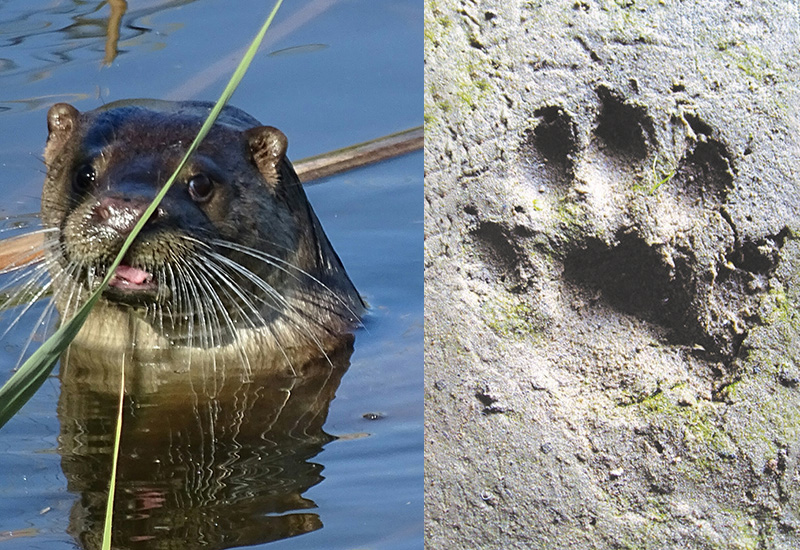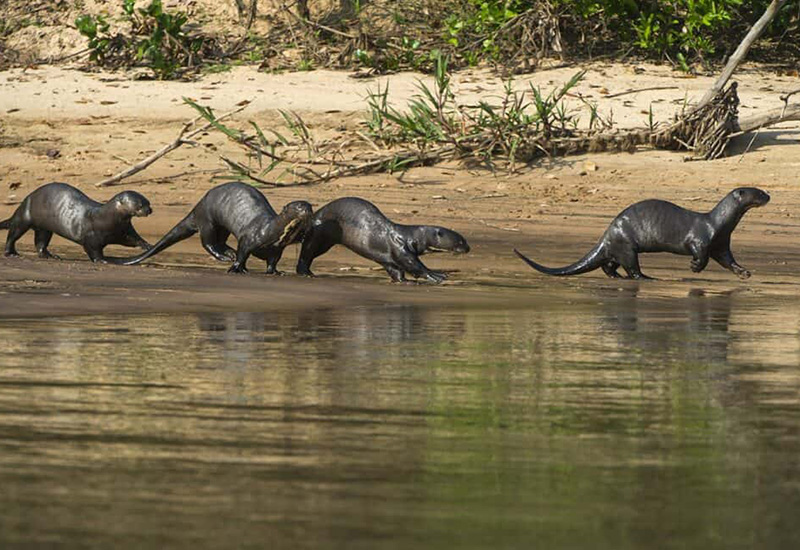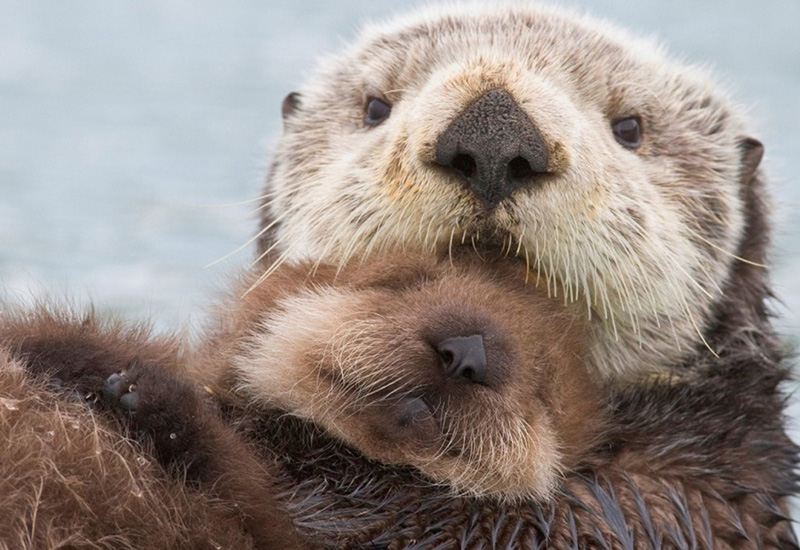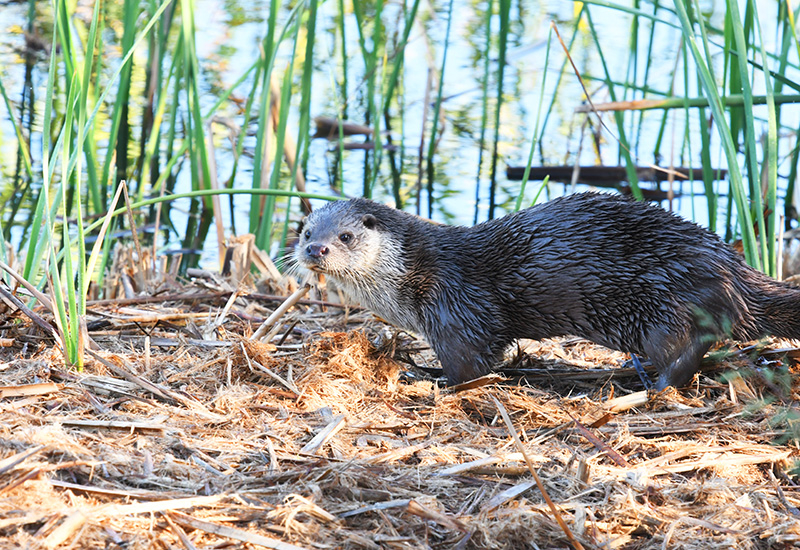One of the animals with the most puns to its name, otters really are amazing creatures that surprisingly inhabit most of the Portuguese territory, including the Algarve. Jokes aside, the Eurasian or European otter (Lutra lutra*) lives across Europe, Asia and even the western regions in North Africa, making it the most widespread of 13 species of otters around the globe. Once hunted for its fur to extremely dangerous low numbers, otters are now protected in most European countries and are making a steady comeback as a top predator in our natural habitats.
Part of the Mustelid family and closely related to weasels, badgers and skunks, Eurasian otters can grow to almost a metre in length and weigh up to 8kg. They are always found near water – rivers, lakes, lagoons, canals and even the sea – anywhere they can hunt for their favourite prey, mainly fish, crustaceous and other invertebrates. If the opportunity presents itself, they will also feed on other animals like small water birds and lizards. Perfectly adapted to a semi-aquatic lifestyle, they can close their ears and nostrils during diving, can see perfectly well under water and come equipped with webbed feet for swim efficiency.
In Portugal, and despite major climatic concerns, water systems, in general, are now better preserved and protected when compared to recent decades. This quality improvement has allowed otters to thrive and spread. The arrival of an invasive crustaceous to most of our rivers could also have been a boost for the otter’s success. Although technically a danger posed to other native species, the Louisiana crayfish provides a year-round food supply to our resident otters.
Usually solitary animals, otters can be difficult to spot and, sometimes, you will see evidence of their presence but not actually see the animal itself. Look out for five-toed footprints or spraint (droppings) on muddy shores. Otters leave their scented spraint in visible places like large stones or fallen tree branches to announce mating season or mark up their territory. The droppings will clearly show fish bones and crayfish shells and have a not-unpleasant smell that has been said to be similar to the fragrance of jasmine!
Once heavily targeted by hunters, otters are today hunted in a more controlled way and real fur is far from being acceptable or fashionable. With little threat from humans and natural predators, an abundance of food and good water quality, the future looks bright and promising for otters in Portugal.
Worldwide, other species of otter are found in Africa, Asia and the Americas. The endangered sea otter (Enhydra lutris), native to North America, is perhaps the cuddliest looking of them all as they genuinely resemble fluffy soft toys. Sea otters spend most of their lives in the ocean, making them the smallest marine mammal. Although they can walk on land, these animals prefer the water and are perfectly adapted to live in the water where they feed, mate and sleep. They even give birth in the water, usually to a single pup that is not able to swim. Luckily it is born with such a thick fur coat that keeps it afloat very comfortably while its mother goes “shopping” for food and until it gets its adult coat of fur and is ready to swim. Their favourite dishes are crab, sea urchins, starfish, clams, fish and mussels. Sea otters are part of a small number of animals that can master the use of a tool. Once they have caught a clam or mussel, they often also pick a stone from the sea bed and then, while floating belly-up, they smash hard shells with the stone to break open the delicious shellfish.

The Oceanarium in Lisbon currently houses two sea otters that were rescued in Alaska as pups but could not be released back into the wild. These are certainly one of the visitors’ favourites.
In South East Asia, small clawed otters (Amblonyx cinereus) are the smallest member of the family, growing only to about 35 cm in length and hardly reaching 5 kg in weight. At the other end of the scales, in South America, you can find the biggest and aptly called giant otters (Pteronura brasiliensis). These large animals can grow to six feet in length and weigh up to 70 kg. They live in family groups that can reach 20 strong and share their territory with some of the most dangerous jungle animals, such as caiman, piranhas, jaguars and anacondas.
The last day Wednesday in May celebrates World Otter Day. A good excuse for a nature walk!
One of the animals with the most puns to its name, otters really are amazing creatures that surprisingly inhabit most of the Portuguese territory, including the Algarve. Jokes aside, the Eurasian or European otter (Lutra lutra*) lives across Europe, Asia and even the western regions in North Africa, making it the most widespread of 13 species of otters around the globe. Once hunted for its fur to extremely dangerous low numbers, otters are now protected in most European countries and are making a steady comeback as a top predator in our natural habitats.

Part of the Mustelid family and closely related to weasels, badgers and skunks, Eurasian otters can grow to almost a metre in length and weigh up to 8kg. They are always found near water – rivers, lakes, lagoons, canals and even the sea – anywhere they can hunt for their favourite prey, mainly fish, crustaceous and other invertebrates. If the opportunity presents itself, they will also feed on other animals like small water birds and lizards. Perfectly adapted to a semi-aquatic lifestyle, they can close their ears and nostrils during diving, can see perfectly well under water and come equipped with webbed feet for swim efficiency.
In Portugal, and despite major climatic concerns, water systems, in general, are now better preserved and protected when compared to recent decades. This quality improvement has allowed otters to thrive and spread. The arrival of an invasive crustaceous to most of our rivers could also have been a boost for the otter’s success. Although technically a danger posed to other native species, the Louisiana crayfish provides a year-round food supply to our resident otters.
Usually solitary animals, otters can be difficult to spot and, sometimes, you will see evidence of their presence but not actually see the animal itself. Look out for five-toed footprints or spraint (droppings) on muddy shores. Otters leave their scented spraint in visible places like large stones or fallen tree branches to announce mating season or mark up their territory. The droppings will clearly show fish bones and crayfish shells and have a not-unpleasant smell that has been said to be similar to the fragrance of jasmine!
Once heavily targeted by hunters, otters are today hunted in a more controlled way and real fur is far from being acceptable or fashionable. With little threat from humans and natural predators, an abundance of food and good water quality, the future looks bright and promising for otters in Portugal.

Worldwide, other species of otter are found in Africa, Asia and the Americas. The endangered sea otter (Enhydra lutris), native to North America, is perhaps the cuddliest looking of them all as they genuinely resemble fluffy soft toys. Sea otters spend most of their lives in the ocean, making them the smallest marine mammal. Although they can walk on land, these animals prefer the water and are perfectly adapted to live in the water where they feed, mate and sleep. They even give birth in the water, usually to a single pup that is not able to swim. Luckily it is born with such a thick fur coat that keeps it afloat very comfortably while its mother goes “shopping” for food and until it gets its adult coat of fur and is ready to swim. Their favourite dishes are crab, sea urchins, starfish, clams, fish and mussels. Sea otters are part of a small number of animals that can master the use of a tool. Once they have caught a clam or mussel, they often also pick a stone from the sea bed and then, while floating belly-up, they smash hard shells with the stone to break open the delicious shellfish.
The Oceanarium in Lisbon currently houses two sea otters that were rescued in Alaska as pups but could not be released back into the wild. These are certainly one of the visitors’ favourites.
In South East Asia, small clawed otters (Amblonyx cinereus) are the smallest member of the family, growing only to about 35 cm in length and hardly reaching 5 kg in weight. At the other end of the scales, in South America, you can find the biggest and aptly called giant otters (Pteronura brasiliensis). These large animals can grow to six feet in length and weigh up to 70 kg. They live in family groups that can reach 20 strong and share their territory with some of the most dangerous jungle animals, such as caiman, piranhas, jaguars and anacondas.
The last day Wednesday in May celebrates World Otter Day. A good excuse for a nature walk!
Otter jokes
Why did the otter marry the walrus? She was not like the otters!
What is the best animal to be on a cold day? A little otter!
*Lutra lutra – a tautonym which is the repetition of the same name, used to classify an animal’s genus and class. A frequent classification in biology (animals) but curiously not allowed in botany (plants).













